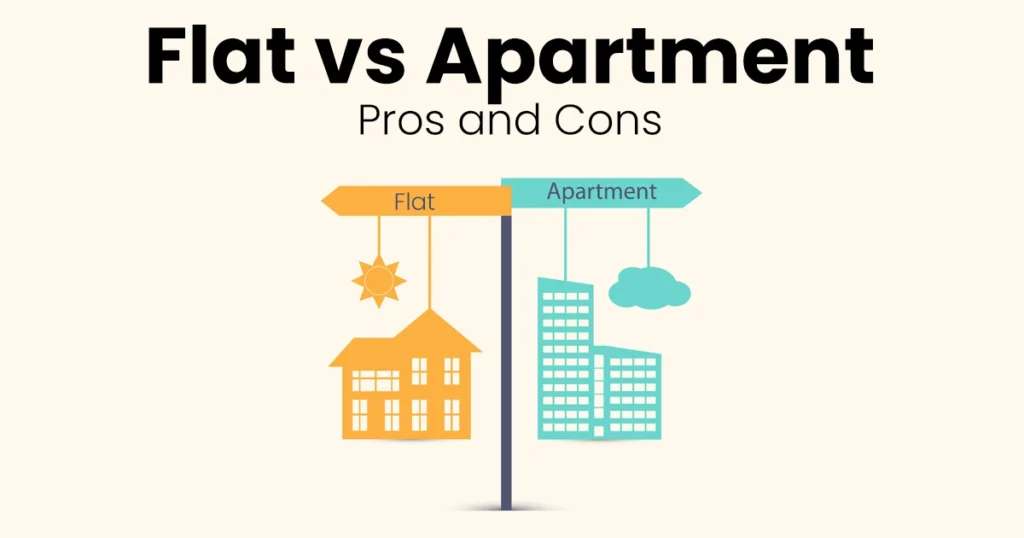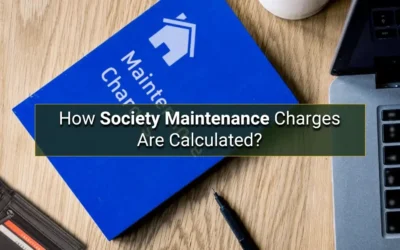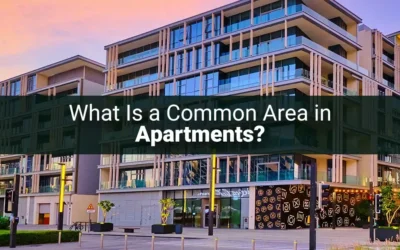You are most likely to have seen the words flat and apartment used interchangeably when you are out looking at houses and even when you have been looking at them online in newspaper adverts. But have you ever wondered — are they the same thing, or is there a deeper difference?
Confused between whether to call your next home a flat or an apartment, not alone. These terms have varying definitions in the real estate business of various locations, and understanding the difference between them can allow you to understand the property market even better, whether you are buying, renting, or investing.
Figure out what the flat vs apartment is all about, what it means, how it is used in various countries, how it compares price-wise, the advantages and disadvantages of these two options, and why you should pick one and why.
What Is a Flat?
The term “flat” is commonly used in British English and in countries like India, Australia, and South Africa. It refers to a self-contained housing unit located on a single floor within a building. A flat is part of a larger residential structure and typically includes:
- Bedrooms
- A living area
- A kitchen
- One or more bathrooms
In India, flats are the most common housing type in cities and are often part of multi-storey residential buildings. These may or may not have elevators, security, or modern amenities depending on the developer and locality.
Also Read: Pros and Cons of Buying a Flat in Bangalore
Key Features of a Flat
- Term commonly used in India and the UK
- Basic layout – usually affordable
- May or may not have premium facilities
- Can range from affordable to luxury, depending on the project
What Is an Apartment?
The word “apartment” is used primarily in American English and is gaining popularity in urban India, especially in metro cities. An apartment is essentially the same as a flat — a housing unit in a multi-unit building — but with an emphasis on modern living, gated communities, and shared amenities.
Apartments are often found in premium or semi-premium housing complexes that offer:
- 24×7 security
- Clubhouses
- Swimming pools
- Gyms
- Elevators and power backups
In India, high-rise residential projects by major developers like DLF, Godrej, Sobha, Prestige, etc., mostly use the term “apartment” to market their homes as luxury or lifestyle-oriented.
Key Features of an Apartment
- Term used widely in the US and Indian metros
- Often part of modern gated communities
- Includes shared amenities and facilities
- More premium branding compared to flats
Flat vs Apartment: The Key Differences
Here’s a quick comparison table to help you understand the distinction better:
| Criteria | Flat | Apartment |
|---|---|---|
| Common Usage | India, UK | US, Canada, Urban India |
| Structure | Single floor unit in a building | Single floor unit, part of a modern complex |
| Amenities | Basic or moderate | Advanced, with clubhouse, gym, etc. |
| Ownership | Can be standalone or in society | Usually part of managed gated society |
| Pricing | Often cheaper | Tends to be more expensive |
| Branding Appeal | Functional | Lifestyle-oriented |
While functionally both are the same, apartments are often perceived as more luxurious or modern, while flats are considered simpler or more traditional.
What Is a Flat Apartment?
Some people use the term “flat apartment” — but technically, that’s just redundant. It’s like saying “chai tea” — they both mean the same thing. You can call your unit either a flat or an apartment depending on where you are.
For example:
- In London, people say “flat.”
- In New York, it’s “apartment.”
- In Mumbai, both are used, but “apartment” is more common in premium areas.
Can a Flat Be Called an Apartment?
Yes. The two are interchangeable in meaning, but context matters.
- If you’re talking to a British buyer or Indian local, saying “flat” makes perfect sense.
- If you’re dealing with NRI clients or marketing to foreign investors, “apartment” sounds more upscale and is more widely accepted internationally.
Are Flats Cheaper Than Apartments?
As a general rule, yes, flats can be cheaper than apartments though not necessarily.
Factors that affect the price:
- Location: A 1 bedroom flat in central Mumbai may cost as much as an apartment in a Tier-2 city.
- Amenities: The apartments generally contain additional items that drive up the price (gym, pool, security).
- Developer Reputation: Premium developers charge more for branded apartments.
- Maintenance: Apartments may have higher monthly maintenance costs.
In India, a basic 2BHK flat in a non-gated society could cost ₹60–80 lakh, whereas a 2BHK apartment in a premium society with amenities might cost ₹90 lakh to ₹1.2 crore or more.
Flat vs Apartment: Pros and Cons

Pros of Flats:
- Usually more affordable
- Can be found in older, well-connected localities
- Lower maintenance fees
- More straightforward property titles
Cons of Flats:
- Fewer amenities
- Older buildings may lack elevators or security
- Less resale value in some cases
Pros of Apartments:
- Modern amenities
- Better security & gated communities
- Preferred by tenants and NRIs
- Often higher rental yields
Cons of Apartments:
- Higher cost and maintenance
- Overcrowded in some complexes
- May have strict society rules
Which Should You Choose: Flat or Apartment?
The answer depends on your priorities:
| Your Priority | Recommended Option |
| Budget-friendly home | Flat |
| Lifestyle amenities | Apartment |
| Investment property | Apartment (higher demand) |
| Simpler ownership | Flat |
| Renting it out | Apartment (attracts more tenants) |
If you’re buying for long-term living and want peace of mind with security, modern amenities, and better resale value — go for an apartment.
But if you prefer cost-effective ownership in a decent location without needing fancy facilities, a flat works perfectly well.
Final Thoughts: Flat vs Apartment – It’s All About Context
While flats and apartments are technically the same, the difference lies in usage, branding, and perception. A flat might sound simple, while an apartment feels modern and upscale — but both serve the same purpose: a comfortable place to call home.
Before deciding, always consider:
- Your location
- Budget
- Lifestyle needs
- Investment goals
So next time you come across the terms “flat” and “apartment,” you’ll know exactly what they mean — and which one suits you best.




